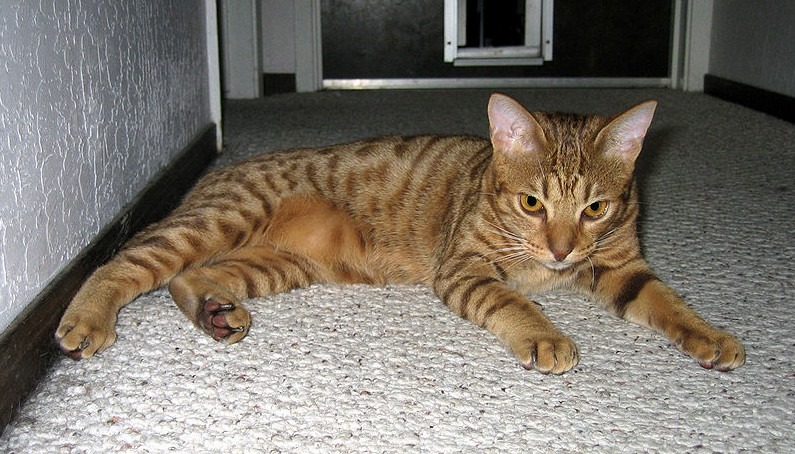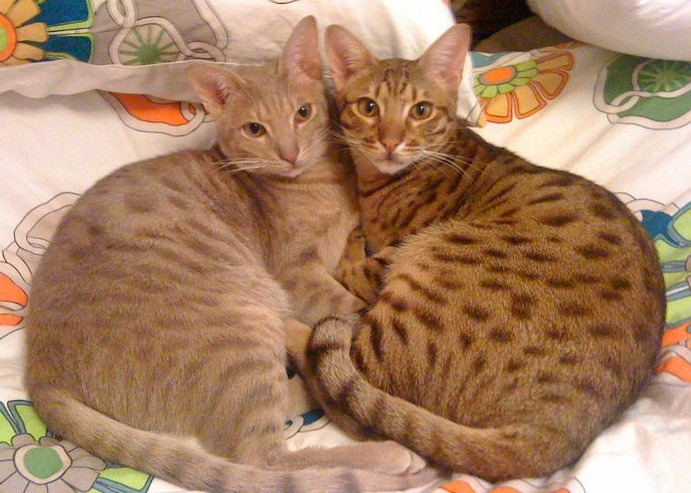Boasting a rugged look from domestic origins, the Ocicat is the only spotted domestic feline breed selectively crossed to resemble the wild cats. It comes in a wide array of colors, such as chocolate, cinnamon, blue, and lavender, to name a few. The feral look is only a facade, though. This cat is wholly people-oriented and playful, relishing the attention of its loving families. As a social pet, it is also amenable to live harmoniously with other cats and cat-friendly dogs, making this furball an ideal companion to most types of homes.
Origin of the Ocicat
Despite its exotic appearance, the Ocicat is far from being wild. Even its ancestry is entirely domestic, and its existence came from a pleasant surprise by breedings the Abyssinian, Siamese, and the American Shorthair cat.
In 1964, breeder Virginia Daly initially wanted to bring Abyssinian points to her Siamese cats, crossing a ruddy-colored Abyssinian male to a seal point Siamese female. The resulting litter sported the Abyssinian-look.
In line with her goal, Virginia then kept one female kitten and bred it with a chocolate point Siamese. The attempt showed some hope, and she continued the breeding process. Soon, one of the litter showed something fresh, a gold-spotted ivory-colored kitten. Virginia’s daughter saw the offspring’s resemblance to the Ocelot, a wild feline native to Mexico, Central and South America, and the southwestern United States. Thus, it was called the Ocicat.
While the result seemed remarkable, it was still not Virginia’s primary goal, resulting in the kitten named Tonga, being sold as a pet. Yet, she still sent a letter to Clyde Keeler, a geneticist, who was then focused on reproducing the Egyptian Spotted Fishing Cat.
The expert suggested Virginia to breed Tonga to his mother. But, since Tonga was already sold, she instead repeated the breeding process and was able to get the same look. Soon, the American Shorthair was added to the gene pool, and other breeders also started their own programs for the spotted cats. In 1986, The International Cat Association (TICA) recognized the breed, followed by the Cat Fanciers’ Association in 1987.
Physical Characteristics of the Ocicat
Length: 9 to 11 inches
Weight: 10 to 15 pounds (Males) 7 to 12 pounds (Females)
Life Expectancy: 12-15 years
Coat Color: Chocolate, tawny, blue, fawn, lavender, cinnamon, silver, and an array of color combinations
Type of Coat: Short, smooth, glossy
Eye Color: All colors
Ocicats boast a robust, powerful body, with heavy boning structures. Their legs are as muscular, accentuated by dark markings. The head is wedge-shaped, with large and pointed ears, tilting at a 45-degree angle, plus almond-shaped eyes. Their conspicuous spots are darkish and contrasting, with the stomach pattern often resembling a bull’s eye mark.
Ocicat Personality
Ocicats are people-oriented felines who love to be with their human companions. They will trail their owners’ footsteps as they go around the house or otherwise ride on their shoulders. Unlike most cat breeds, these furballs would not care being carried around as long they are with their loving families.
With their cheery personality, guests would not faze them. In fact, Ocicats would be happy to welcome them and take it as a new moment for lap sitting and petting. However, given their love people, they are unfit for homes with members who are always out of the house, as these felines will surely don’t like being left alone.
Due to their Siamese ancestry, Ocicat can also be vocal but not as loud as their Siamese progenitors and certainly, not as nagging.
Moreover, these furballs are highly intelligent and can learn tricks or walk on a leash if adequately trained. Puzzle and interactive toys are suitable investments and can help stimulate their minds. However, with such brilliance, it is best to keep anything essential away from their reach and ensure all points in the house are locked. These cats can quickly figure out how to undo latches or open doors and cabinets.
Lastly, Ocicats are blessed with athleticism, having the ability to climb the house’s highest points. That’s good for the owners as they will have no difficult time finding them, as these are often perched on high just watching over their beloved family members.
Caring for the Ocicat
Ocicats are a low-maintenance breed. Their short, dense coat only requires weekly brushing to keep it in its tip-top condition. However, an excellent way to make their fur lustrous is by polishing them with a chamois cloth, bringing out the best in their satiny coat.
Other grooming requirements include dental hygiene, nail trimming, and ear cleaning. It is best to acquaint these cats with the said activities at a young age to make the moments as painless as possible when they grow up.
Given their robust, muscular bodies and powerful legs, they will love to climb. Providing them with high perches and cat trees to view the outside will surely make them happy. However, they also need horizontal space where they can run around and consume their energy.
As for their health, Ocicats are relatively sturdy, though it can be vulnerable to certain conditions, such as progressive retinal atrophy, liver or renal amyloidosis, and hypertrophic cardiomyopathy. Regular consultations with the vet is a great way to detect and prevent any condition and ensure a long, healthy life for these adorable felines.
Ocicats are ideal for owners who are looking for people-oriented and active cats for their homes. While they may look wild, these cats are far from feral and will enthusiastically entertain their families with their brilliance and friendly and social demeanor.




